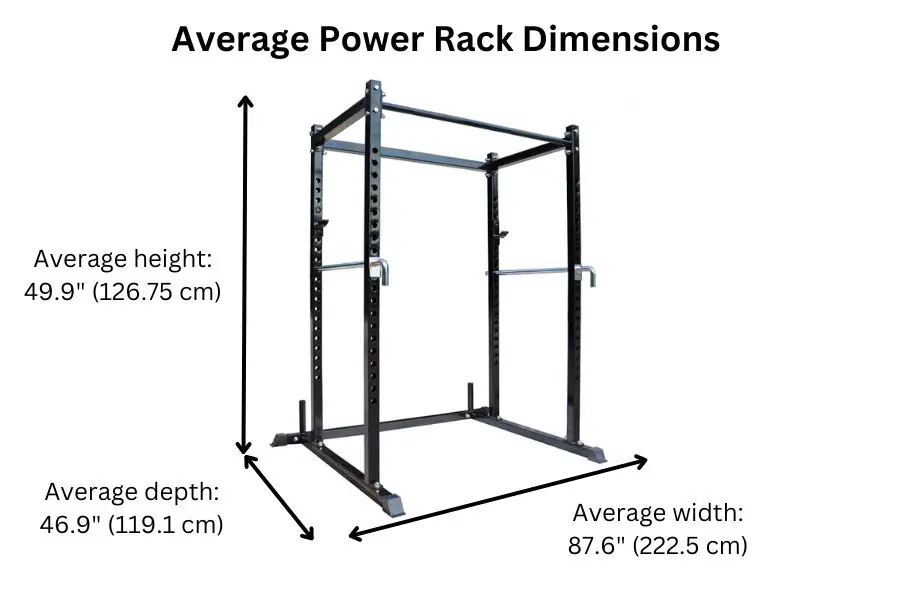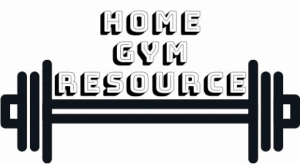A power rack is a piece of weightlifting equipment that you can’t miss out on if you want to use barbels. These squat cages are large pieces of equipment though. How much space do they take up exactly? I’ve compiled a list of many popular racks so you can find out how much space you need.
The average dimensions of a power rack are;
The average outside dimensions of a power rack for a home gym are 49.9” (W), 46.9” (D), and 87.6” (H) (126.75 x 119.1 x 222.5 cm). To use a power rack to its full potential, keep 3’ free on each side and 4.5’’ in front. Having 16” of headroom above the pull-up bar allows for full range pull-ups.
Below you can find a list of power rack dimensions, and some observations on the averages and size ranges. The footprint of a power rack isn’t the only space you need to properly use a squat cage. You’ll need some free space around the rack which we’ll get into as well.
Contents
Power Rack Dimensions List
Here are the dimensions of many popular power racks. These are simple racks with four upright posts for a home gym. For commercial gyms, there are bigger ones available but for in a home gym, those are often too big and unnecessary.
| Brand | Model | Height (in) | Width (in) | Depth (in) |
|---|---|---|---|---|
| Titan Fitness | T-2 Short | 71.5 | 58 | 48 |
| Titan Fitness | T-2 | 83 | 48 | 48 |
| Titan Fitness | T-3 Short | 82.25 | 53.25 | 44.75 |
| Titan Fitness | T-3 | 91.12 | 53.25 | 44.75 |
| Titan Fitness | X3 Short | 82 | 48 | 50 |
| Titan Fitness | X3 | 92 | 48 | 50 |
| Rogue | RML-390C | 90.375 | 53 | 40 |
| Rogue | RML-390F | 92 | 49 | 48 |
| Rogue | RML-490C | 90.375 | 53 | 53 |
| Rogue | R-3 Shorty | 84 | 53 | 34 |
| Rogue | R-3 Standard | 90 | 53 | 34 |
| Rogue | RM-4 Short | 90 | 49 | 49 |
| Rogue | RM-4 Medium | 100 | 49 | 49 |
| Rogue | RM-4 Tall | 110 | 49 | 49 |
| REP Fitness | PR-4000 Short | 80 | 50.8 | 29,9-49,9 |
| REP Fitness | PR-4000 Tall | 93 | 50.8 | 29,9-49,10 |
| Fitness Reality | 810XLT | 83 | 46 | 50 |
| HulkFit | Pro Series Cage | 85 | 44 | 47 |
| Cap Barbell | Power Cage 6’ | 72 | 43.6 | 47.5 |
| Cap Barbell | Power Cage 7’ | 84 | 43.6 | 47.5 |
| Signature Fitness | SF-3 | 83.5 | 51.2 | 38.8 |
| Technogym | Olympic Rack | 97 | 51 | 66 |
| Average | 87.6 | 49.9 | 46.9 |

Squat Cage Dimension Observations
Here are some quick observations you can make from this list.
How Wide Is a Power Rack?
The width of a typical power rack, including the stabilizer feet or tabs that are bolted to the floor, averages around 49.9 inches (126.75 cm).
However, the outside width of the upright posts, which can vary slightly depending on the model, is slightly narrower than this total width. In most cases, the width between the outsides of both upright posts is generally 49 inches or less. This width limitation is designed to accommodate full-length barbells, which typically have 51.5 inches of shaft length between the collars that need to fit securely on the rack.
The upright posts themselves come in two common widths, either 2 inches or 3 inches, depending on the specific model. Consequently, the opening or space between the upright posts usually falls within the range of 42 inches to 45 inches wide, although there may be some exceptions with narrower dimensions.
In summary, the width of a power rack is a critical consideration when setting up a home gym, as it determines the available space for exercises and ensures that standard-sized barbells can fit securely within the rack.
Average Power Cage Depths
The total outside depth of an average power rack typically measures around 46.9 inches (119.1 cm).
It’s important to note that this measurement includes the additional space taken up by braces and stabilizing feet. While the upright posts inside the rack are typically a bit closer together, the total outside depth is the key factor to consider when determining the floor space required for your home gym setup.
Within the rack itself, meaning the space between the front and back upright posts, the depth typically ranges from 24 inches to 36 inches. However, it’s worth noting that there can be variations and exceptions to these dimensions, so it’s essential to check the specific measurements of the power rack you’re interested in to ensure it suits your workout space and equipment needs.
Some power racks have different options for inside depth. Titan and REP are some examples of brands that make racks where you can choose the same racks with different depths.
How Tall is a Squat Cage?
Power racks come in a diverse range of heights to accommodate various workout spaces.
On average, power racks are around 87.6″ tall (222.5 cm). However, this measurement can vary significantly, with power racks available in heights ranging from 71.5 inches to 110 inches (180 to 279.4 cm).
When considering the height of a power rack, it’s crucial to ensure it fits comfortably within your room’s ceiling clearance. Simultaneously, you’ll want to factor in the headroom above the pull-up bar, as this determines whether you can perform pull-ups without the risk of hitting your head. Since the pull-up bar is positioned at the top, front section of the rack, prioritizing a power rack tall enough to prevent head contact with the bar becomes more important, particularly if you have low ceilings.
How Much Space Do You Need For a Power Rack?
Here’s a quick summary of how much space you need around your power cage to be able to use it properly. If you want more information, click this link, which will lead you to an in-depth article about the space requirements of a power rack.

